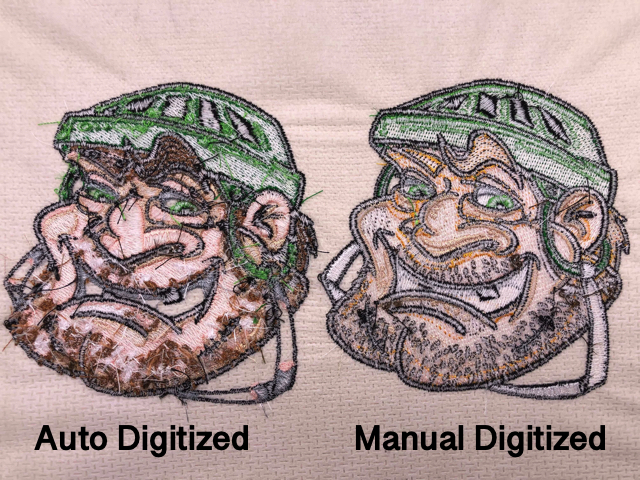High-grade Digitizing for Embroidery: Specialist Workmanship
High-grade Digitizing for Embroidery: Specialist Workmanship
Blog Article
Simplifying the Art of Embroidery Digitizing: Step-by-Step Guide
Needlework digitizing is a careful craft that requires precision and imagination. As technology remains to breakthrough, the digitization process has actually come to be extra available, enabling enthusiasts to bring their elaborate styles to life effortlessly. In this guide, we will decipher the intricacies of embroidery digitizing, damaging down each step carefully to enhance the process and equip both newbies and experienced embroiderers alike. Stay tuned to uncover how you can simplify this intricate art form and transform your imaginative visions into perfectly stitched work of arts.
Understanding Needlework Digitizing Software
Embroidery digitizing software program serves as an important device for transforming detailed designs right into electronic formats suitable with needlework devices, helping with specific stitching and modification. This specific software permits users to import numerous picture file formats, such as JPG or PNG, and transform them into embroidery machine-readable layouts like DST, EXP, or PES - Digitizing for Embroidery. By utilizing features like stitch modifying, underlay options, and string shade choice, digitizing software program allows individuals to manage every aspect of the design process
Additionally, advanced needlework digitizing software supplies tools for developing complex layouts, adjusting stitch density, and integrating intricate information. Users can also sneak peek the layout prior to sewing it out, making sure accuracy and decreasing mistakes. Furthermore, several software program programs give automated attributes that help simplify the digitizing procedure, conserving time and effort.
Understanding the capacities of needlework digitizing software program is crucial for attaining high-grade lead to needlework jobs. By grasping this tool, embroidery fanatics and specialists can unleash their creativity and bring elaborate designs to life with accuracy and performance.

Picking the Right Design File
After familiarizing yourself with the abilities of embroidery digitizing software application, the following essential action in the process is choosing the right style declare your job. Digitizing for Embroidery. When picking a style declare needlework digitizing, it's important to take into consideration the intricacy of the design, the size of the last item, and the kind of fabric you will be dealing with
For detailed styles with fine information, a high-resolution photo or vector data is suggested to make sure that the embroidery machine can properly replicate the style. Additionally, the dimension of the last product plays a substantial function in selecting the right layout documents. Bigger layouts may need higher resolution data to maintain clarity and intensity.
Moreover, the type of fabric you will certainly be embroidering on affects the option of layout data. Various materials you can look here might need adjustments in the layout documents to ensure that the stitches are appropriately aligned and the design looks like planned. By thoroughly picking the right design data based upon these variables, you can establish on your own up for a successful embroidery digitizing procedure.
Digitizing Devices and Strategies
Utilizing specialized software and precision methods, digitizing tools are crucial in transforming elaborate layouts into embroidery-ready documents. Embroidery digitizing software application, such as Wilcom, Hatch, or Embrilliance, gives the required platform to transform art work right into stitch information. These programs supply attributes like stitch editing, underlay options, and lettering tools to make sure the style translates effortlessly onto material.
One of the vital techniques in digitizing is producing a clear course for the embroidery machine to follow. This includes digitizing each element of the layout with precision, establishing stitch kinds, densities, and directions. By utilizing devices like digitizing tablet computers or software-specific plugins, embroiderers can attain a high level of accuracy in their digitized designs.
In addition, mastering the art of rug sewing is crucial website here for creating high quality needlework. Underlay stitching supports the textile and produces a foundation for the design, making certain that the end product is both visually appealing and long-lasting. By understanding these digitizing devices and methods, embroiderers can raise their craft and bring detailed designs to life with accuracy and performance.
Personalizing Stitch Kinds and Instructions
The option of stitch types can substantially impact the general appearance and appearance of the embroidered layout. By strategically combining these stitch types, embroiderers can attain depth and measurement in their designs.
Furthermore, the instructions of stitches plays a crucial function in boosting the visual appeal of the last embroidery. By experimenting with various stitch angles and patterns, redirected here embroiderers can bring their styles to life with remarkable detail and details.
Screening and Refining Your Digitized Style
To ensure the accuracy and quality of your digitized design, comprehensive screening and improvement are necessary steps in the needlework digitizing procedure. As soon as you have actually completed the digitization of your design, it is crucial to check it before waging the real embroidery. Testing enables you to recognize any type of prospective issues such as string breaks, sew density problems, or design distortions that might impact the outcome.

After screening, it is essential to fine-tune your digitized design based upon the responses from the test sew-out. This may entail tweaking sew setups, changing densities, or making changes to the total design to attain the wanted outcome. By iterating through screening and refinement, you can fine-tune your digitized layout to excellence prior to relocating ahead with the actual embroidery procedure.
Verdict
Finally, mastering the art of embroidery digitizing needs a comprehensive understanding of the software, choosing the right layout data, making use of digitizing devices and techniques, tailoring stitch types and instructions, and testing and refining the digitized layout. By complying with these actions, embroiderers can simplify the digitizing process and create premium stitched styles with accuracy and effectiveness.
Report this page